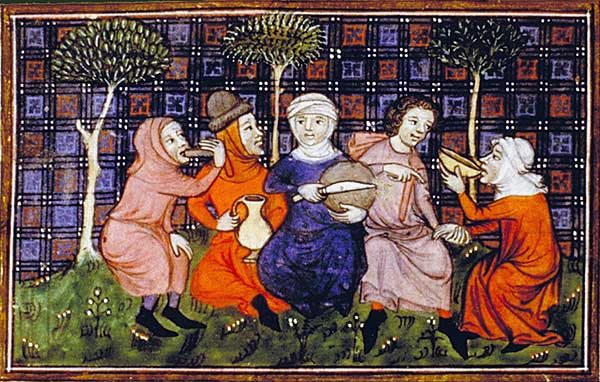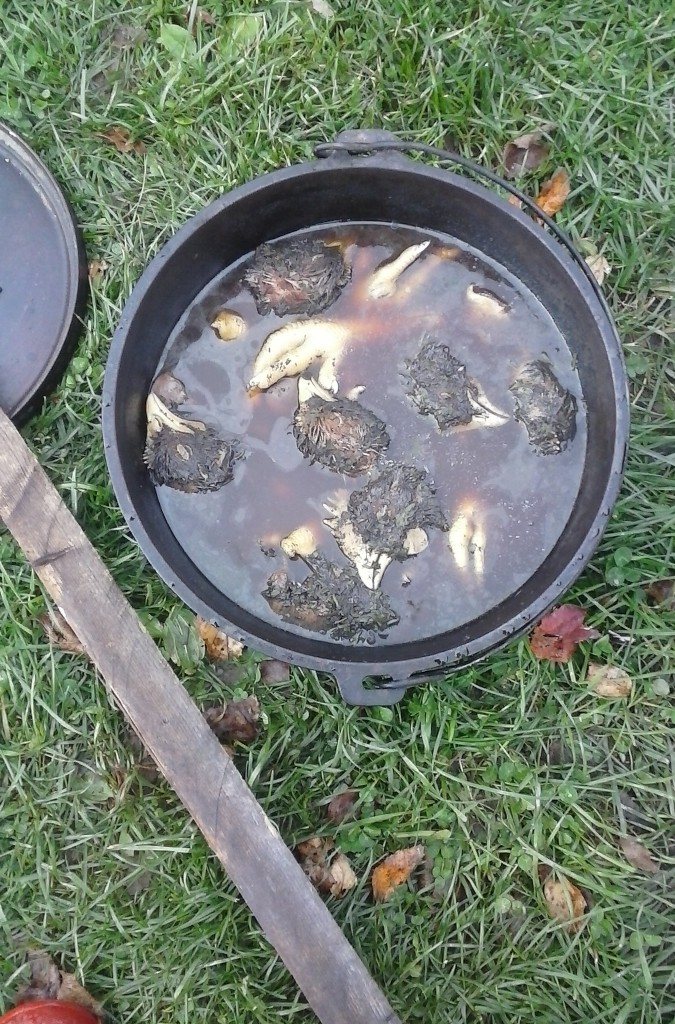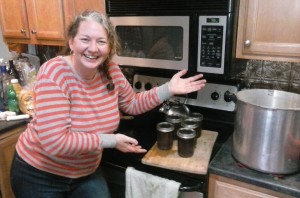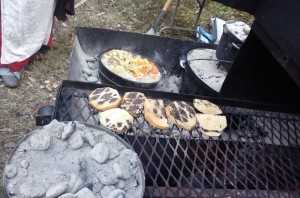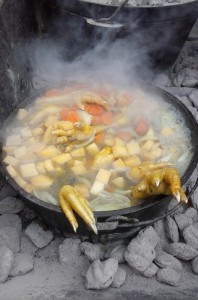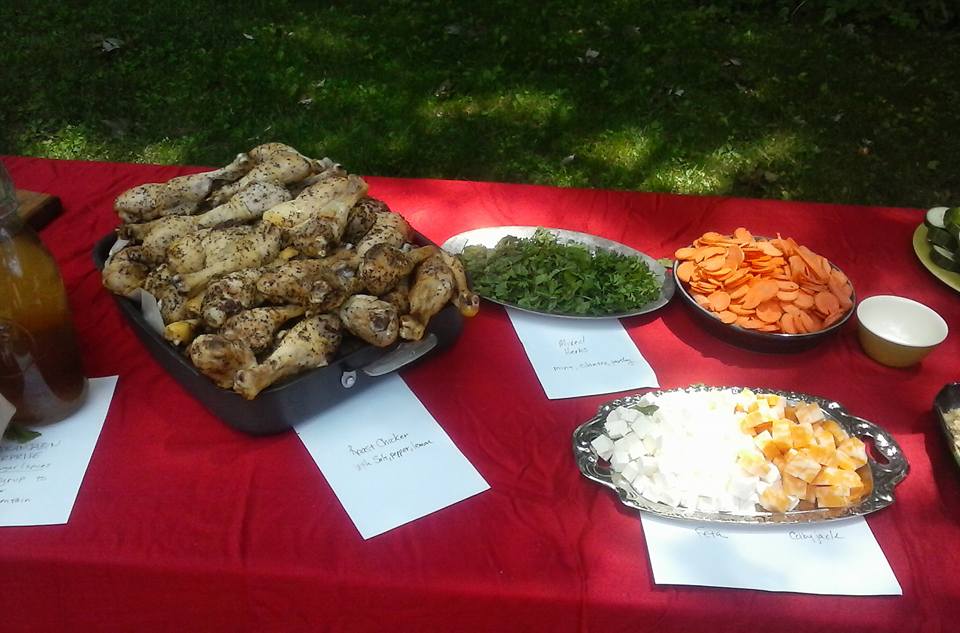A very dear friend and Thanet house-brother, Ane du Vey, was to be elevated to the Order of the Chivalry at the Great Northeastern War in Malagentia in mid-July, 2015. I was invited to create the vigil menu to share hospitality with visitors who were coming to visit Vey as he sat vigil.
It was important to me that the food be period-possible for the most part, with influences of period spices and simple foods. Vey prefers simple things like roast meat, so I created things I knew he would enjoy. Also, because there would be many coming who had been fighting during the day, I included some loving nods to a field dayboard incorporating gatorade, oranges, pickles, and pepperoni – all items which are regularly eaten field-side between battles.
I prepared the majority of the food, since I can do food, but I can’t sew, and that’s what everyone else was doing to get ready. The day of the event, Lady Thallos of Brighton Hall, Lady Agatha Wanderer, Lady Lucie Lovegood, m’Lady Alesone and her lord Absolon of the Debatable Lands, and other members of Thanet House assisted with the plating and setup.
Lucie and Lord Alaric did a number on the dish cleaning in the morning.
This is the menu for that event. We believe that about 200 people visited the camp and we served food from roughly 5pm through 2am.
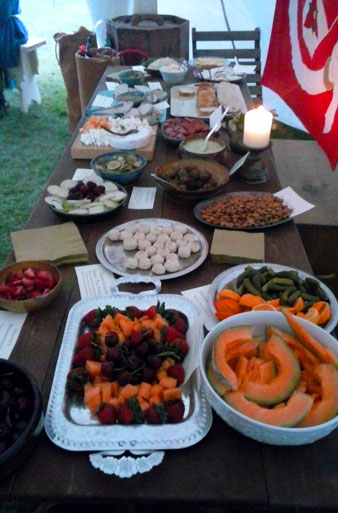
Fresh Fruit in Season -Strawberries, Cantaloupe, Cherries, and Pears. I tried to choose fruits that would have been available in period, having been in fashion in 14th c. Italy, brought by the Arabs in southern Spain.
Strawberries in Elderflower Liquor. A little bit of beautiful, floral liquor helps keep the strawberries in good shape and tastes and smells amazing.
Fighter’s Tray. Sliced oranges and small dill pickles. Since it’s the food most often eaten by fighters, I included it on the menu as a nod to the regular fighter’s dayboard.
‘Adjari: The Virgins’ – Rosewater shortbread cookies. These Arabic “adult butter cookies” are so named because you are to make the dough and then “form like the breasts of the virgins” and bake them. These were flavored with rosewater and dusted with edible gold dust. (Recipe from “Scheherazade’s Feasts – Foods of the Medieval World” – http://www.amazon.com/Scheherazades-Feasts-Foods-Medieval-World/dp/081224477X)
Almonds – raw, plain almonds. Almonds were popular in the middle ages, as now. They are good protein and easy to eat without mess.
Meatballs in Green Sauce – commercial gluten-free Italian meatballs with a fresh green sauce of basil, green onion, parsley, cider vinegar, garlic, and sugar. These are always a gigantic favorite. The dressing would be amazing on pretty much any kind of food. (It’s a little like this: http://www.godecookery.com/nboke/nboke27.htm and this http://www.godecookery.com/nboke/nboke06.htm and http://www.godecookery.com/nboke/nboke65.html but with parsley and basil sharing the flavor weight.)
Roast Pork Loin – pork loin roasted with lemon, pepper, salt, and garlic served with large-grain, homemade mustard.
Sausages – pepperoni and hard sausage finely sliced
Bread and Honey Butter – an SCA staple (and one of Vey’s favorite things)
Roast Garlic Cloves – garlic cloves roast in olive oil
Garlic Hummus – homemade hummus of chickpea, tahini, parsley, salt, pepper, fresh garlic
Moretum – a Roman feta and garlic herbed cheese spread. I included feta and ricotta both with fresh, sharp garlic, celery, coriander, and salt. I omitted rue. (http://www.godecookery.com/friends/frec70.htm)
Toasted flatbread points – flour tortillas toasted on a pan and cut into slices (we also had corn tortillas for our gluten-free friends)
A Plate of Cheeses: feta, chevre, colbyjack, and brie
Quick Dill Cucumbers – cucumbers in vinegar, garlic, many herbs and spices and sugar
Beverage: Orange Beverage for Fighters – orange Gatorade
Beverage: Sekanjabin – lemon lavender sekanjabin
Beer & Mead – There were several varieties of beer provided by brewers in the Barony of Endewearde. Mistress Sylvia du Vey provided mead.
Also part of the spread were some food gifts – a loaf of homemade bread, and some of Lady Rose’s amazing salsa served with corn chips – also some of Vey’s favorite things.
Saturday’s Two Knight Show
We repeated the menu, mostly, for a dual party for Sir Vey and Sir Ed McGuyver on Saturday night. Anything we had not placed out the night before was plated and sent, augmented by breads, spreads, salsas, chips, many cookies, and much beer and mead. I know that Lady Rose had a large hand in those provisions.
In addition to the help from the night before, my husband Andre helped, as did Sir Cedric of Amorica and – at the end of the night when the candles had burned low – Sir Matthew Moraveous stayed to assist with cleanup of the main tent.
The next morning when I finally rose, I found Sir Vey himself washing the dishes.
Many were fed. It feels like loaves and fishes at Thanet sometimes.
